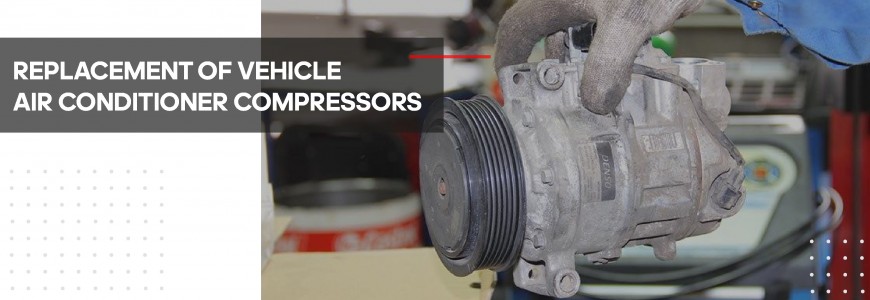
- Specifics of vehicle climate systems repair
- Compressor replacement: operations performed by repair specialists
- The need for a unit replacement unit and system flushing
- Installation and filling of a new compressor at Master Service workshops
- First start-up and testing of an air conditioner
A compressor is the main unit of a vehicle system. It pumps the refrigerant and builds the pressure sufficient for its condensation.
At the same time, a compressor is the most high-failure component of a vehicle. To repair a compressor, it is necessary to know where exactly the fault is, as well as to assess the compressor's technical condition in general. Another important thing is to follow the technology of repair.
MSG Equipment specialists have developed both: test bench MS111 for AC compressors and flushing stand MS101P. These two pieces of equipment are essential for any auto workshop specialized in the repair of air conditioners. They will be useful for different types of repair.
Special aspects of a vehicle climate system repair
There are several manufacturer-provided recommendations concerning the repair of climate systems. Following these recommendations and the rules for air conditioner operation will ensure its long service life and smooth performance.
1. Recommendations on the amount of refrigerant, oil, and UF dye that should be charged to the system, must be strictly adhered to. For example, the excess of oil impairs heat transfer in the condenser and evaporator, while the lack of oil leads to the compressor oil starvation and shortens its service life.
2. Air conditioning systems have some non-reusable components and units in their design that must be replaced during a repair (for example, aluminum tubes).
3. The use of "repair" substances (for example, a sealer for the elimination of leaks) in the repair of climate systems is strictly prohibited.
Let’s take a closer look at the air conditioner repair procedure performed by specialists of Master Service auto workshops. Problem: the seizure of a cylinder-piston group.
Replacement of a compressor: a list of operations performed by a technician
If compressor pistons are seized, the unit must be replaced. To replace the compressor, a technician performs a number of operation as follows:
- evacuates refrigerant from the system;
- dismantles the faulty compressor, filter-dryer, condenser, orifice tube, and thermal expansion valve (TEV);
- connects the flushing equipment and cleanses the system;
- dries the system with inert gas;
- installs an orifice tube and a thermal expansion valve;
- tests the new compressor on test bench MS111;
- installs the new compressor, condenser, and filter-drier;
- pumps and purges the system;
- fill new refrigerant and oil into the air conditioner;
- checks the system performance
Assembling the system components, the technician places new sealing elements.
Why is it necessary to replace some of the units and flush the system?
When a compressor fails, it must be replaced. Flushing of the system ensures a long and trouble-free operation of an air conditioner. Why do we need to do all of these?
When moving parts of a compressor wear and a Teflon protective coating is damaged, metal chips get into the oil and refrigerant. System flushing is required to remove the particles. Flushing stand MS101P cleanses the system with a pulsating flow of either flushing fluid R141B or isopropyl alcohol. Both fluids proved perfect for the task. After flushing, their remaining portions can be easily removed from the system.
However, a mixture of viscous oil and chip is hard to remove from the system's narrowest places. Being accumulated in the condenser tubes, an orifice tube, a thermal expansion valve, and aluminum pipelines, this mixture is almost impossible to wash out. That is why these components must be replaced in the process of repair.
Installation of a new compressor and the system filling
Master Service workshop specialists always check the compressor on test bench MS111 before mounting it on a car thus, excluding the possibility of installation of a faulty or poorly repaired compressor. In case when a non-genuine compressor is installed at the client's option, it will be run-in on test bench MS111.
As we mentioned earlier, a correct refrigerant-to-oil ratio ensures the trouble-free operation of a compressor. This ratio will not be optimum, for example, at the system's first start-up or after a continuous idle time.
Drain the used oil and add 20-30g of the new one after running-in the compressor on test bench MS111 and before its installation on a vehicle. Then, use a filling station to charge the system with the refrigerant and necessary amount of oil. This way, the correct Freon-oil ratio will be achieved.
The first air conditioner start-up and testing
Last step: the technician tests the climate system performance in a car. The procedure is as follows:
- he starts the engine and keeps it running at minimum rpm;
- as soon as the engine temperature reaches its operating value, he switches on the air conditioner in the cabin to its maximum temperature – this way, compressor displacement is maximum;
- the technician selects a low or medium speed of the evaporator fan, i.e., he sets a low load on the compressor. The air conditioner operates in this mode for 15-20 minutes so that the moving parts of the compressor could work in, and the oil would be uniformly distributed in the system.
Once this is done, the system is ready for regular operation,



COMMENTS